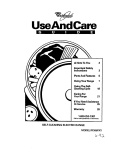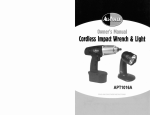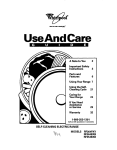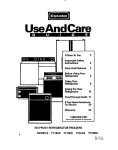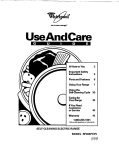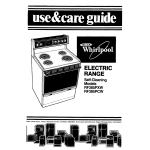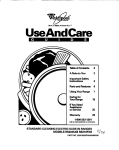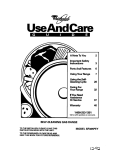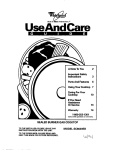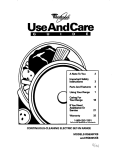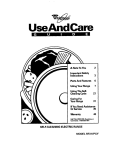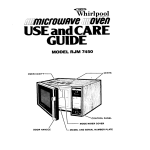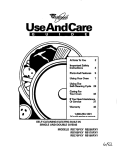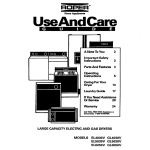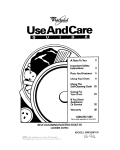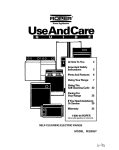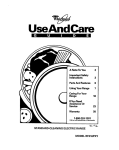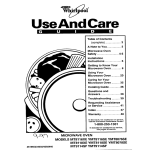Download Whirlpool RF376PXY User's Manual
Transcript
A Note To You 2 Important Safety lnstnxtions 3 Parts And Features 6 Using Your Range 7 Using The SelfCleaning Cyde 28 Caring For Your Range 32 tf You Need Assistance Or Setice 36 40 Warranty 1-800-253-1301 Cell us with questions or comments. SELF-CLEANING ELECTRIC RANGE MODELS RF376PXY RF376PCY A Note To You Thank you for buying a Whirlpool appliance. You have purchased a quality, wotid+zlass home appliance. Years of engineering experience have gone into its manufacturing. To ensure that you will enjoy many years of trouble-free operation, we have developed this Use and Care Guide. lt is full of valuable information on how to operate and maintain your appliance properly and safefy. Please read it carefully. Also, please complete and mail the Ownership Registration Card provided with your appliance. This will help us notify you about any new information on your appliance. Your safety is important to us. This guide contains safety symbols and statements. Please pay special attention to these symbols and follow any instructions given. Here is a brief explanation of the use of each symbol. This symbol will help alert you to such dangers as personal injury, burns, fire and electrical shock This symbol will help you avoid actions which could cause product damage (scratches, dents, etc.) and damage to your personal property. Our Consumer Assistance Center is toll-free, 24 hours a day. number, l-800-253-1301, lf you ever have a question concerning your appliance’s operation, or if you need service, first see ‘If You Need Assistance Or Service” on page 36. If you need further help, feel free to call our Consumer Assistance Center. When calling, you will need to know your appliance’s complete model number and serial number. You can find this information on the model and serial number plate (see diagram on page 6). For your convenience, we have included a handy place below for you to record these numbers, the purchase date from the sales slip and your dealer’s name and telephone number. Keep this book and the sales slip together in a safe place for future reference. Model Number Deale<Narne Serial Number Dealer Phone Purchase Date Important Safety Instructions To reduce the risk of fire, electrical shock, injury to persons, or damage when using the range, follow basic precautions, including the following: General Read all instructions before using the range. @Install or locate the range onl in accordance with the provi dyed Installation Instructions. The l ‘WARNING: To reduce the risk of ti ping of the appliance, the app Piance must be secured by a roperly installed anti-tip Eracket. To check if the bracket is installed;properly, see “The anti-tip bracket” on page 27. ‘CAUTION: Do not store things children mi ht want above the range. Chil %ren could be burned or injured while climbing on it. ‘Do not leave children alone or unattended in area where the range is in use. They should never be allowed to sit or stand on an part of the range. They could Jbe burned or injured. DDo not operate the range if it is damaged or not working properly. ‘Do not use the range for warming or heatin the room. Persons could be %urned or injured, or a fire could start. *Use the range only for its,in- . t;;i;iluse as described In this . *Do not touch surface units, areas near units, heating elements or interior surfaces of oven. Surface units and heating elements may be hot even though they are dark in color. Areas near surface units and interior surfaces of an oven become hot enou h to cause bums. During an cpafter use, do not touch, or let clothing or other flammable matenals contact surface units, areas near units, heatin elements or interior surfaces 03 oven until they have had sufficient time to cool. Other surfaces of the range may become hot enough to cause burns; such as, the oven vent opening, the surface near the vent opening, the cc~~~o~, the oven door and . *Do not wear loose or hanging garments when using the range. They could ignite if they touch a hot surface unit and you could be burned. continued on next page 3 *Use only d potholders. Moist or damp por holders on hot surfaces ma result in bums from steam. b 0 not let potholder touch hot heating elements. Do not use a towel or bulk cloth for a potholder. It coul J catch on fire. *Keep range vents unobstructed. DO not heat unopened containers. They could explode. The hot contents could cause bums and container particles could cause injury. *Do not store flammable materials on or near the range. The fumes can create an explosion and/or fire hazard. @Check to be sure glass cooking utensils are safe for use on the range. Only certain types of glass, glass-ceramic, ceramic, earthenware or other glazed utensils are suitable for cooktops without breaking due to the sudden change in temperature. ONever leave surface units unattended at high heat settings. A boilover could result and cause smoking and greasy spillovers that may ignite. When *Turn pan handles inward, but not over other surface units. This will help reduce the chance of bums, i niting of flammable materia 9 s, and spills due to bumping of the pan. When using the oven using the cooktop *Do not cook on a broken cooktop. If cooktop should break, cleaning solutions and spillovers may penetrate the broken cooktop and create a risk of electrical shock. Contact a qualified technician immediately. *Select a pan with a flat bottom that is about the same size as the surface unit. If pan is smaller than the surface unit, some of the heatin element will be.exppsed an % may result ~~~~l~~~n~~~~~t~~~~~e also improves cooking efficiency. *Always osition oven rack(s) in desired Pocation while oven IS cool. If a rack must be removed while oven is hot, do not let potholder contact hot heating element in oven. @Use care when opening oven door. Let hot air or steam escape before removing or replacing food. Grease *Grease is flammable. Do not allow grease to collect around cooktop or in vents. Wipe spillover’s immediately. c I *Do not usexase fires. Never pick up a flaming pan. Smother flamin pan on range by coverin WI9 h a wellfitted lid, cookie s91eet or flat tray. Flaming grease outside of an can be extin uished with Eaking soda or, i? available, a multipurpose dry chemical or foam-type extinguisher. Care and cleaning *Clean cooktop with care. Some cleaners can produce noxious fumes if applied to a hot surface. If a wet paper towel is used to wipe s ills on a hot cookin area, g e careful to avoid s9 earn bums. *Small amounts of formaldehyde and carbon monoxide are iven off in the Self-Cleaning cyc9e from fiberglass ins,ulatlon and food decomposition. Si nificant exposure to these subs9 antes can cause cancer or reproductive harm. Exposure can be minimized by venting with a hood or o en window and wiping o up excess food spills prior to self-cleaning. *Do not use oven cleaners. No commercial oven cleaner or oven liner rotective coating of any kind s Rould be used in or around any part of the oven. *Before self-cleaning the oven., remove broiler an, broiler rid, oven racks an cf other utensr9 s. Do not use your oven to clean miscellaneous parts unless you are instructed to do so in this Use and Care Guide. *Do not clean door heat seal. It is essential for a good seal. Care should be taken not to rub, damage or move the seal. Clean only parts recommended in this Use and Care Guide. *Do not repair-or replace any part of the range unless specifitally recommended in this manual. All other servicing should be referred to a qualified technician. *Disconnect the electrical supply before servicing the range. - SAVE THESE INSTRUCTIONS - 5 Parts And Features This section contains captioned illustrations of your range. Use them to become familiar with the location and appearance of all parts and features. control panel ) Ovan vent CleanTopN ceramic cooktop Surface unit y 31 ?A*-- Hot Sutface Indicator lights Automatic /% Mode4 and serial number plate - Broil element Lock lever y Bake element .Remoyable storage drawer Control panel Oven selector control 6 knob heating indicator Oven temperature control knob indicator light Elecbonlc HEALTIMER” clock with oven controls and minute timer light Manual OV(WI light switch control Right front control knob knob unit marker Using Your Range ’ In This Section Page lJ8lng the surfaw units ----1---1-17 Positioning and pans -..------0 raclo For best air drculdon U&g alumhum The electronic Setting -..--...---,-.lo ------- the clock ------------ Broiling ..---..-.-..-.-.--...---... Broiling tips -.-...-.......-...--.- l aving 10 Energy Using the ele&ronIc 12 The oven vent ,---....---,---B-26 tlpo __-- control ,.17 The storage drawer _---...--- -..I_ .._. 13 bracket . . ..“..“..“.......“.......“....I.. . ..“.“..........................“..”..”.... 14 Using the Off/Cancel pad II ..-.....“. Optional 16 -.-...-.,---16 MEALTiMER”contrd The anti-tip Minute Timer --.._. --14 15 ---- -,..13 Using the electronic Baking/roasting lhs oven temperature 11 foil for baking ------.. oven control8 Page Adjusting --I.. door panel pat “..“....““........“...“...” 26 27 27 TO obtain the best cooking results possible, you must operate your range properly. This section gives you important information for efficient and safe use of your range. Using the surface units Control knobs must be pushed In before turning them to a setting. They can be set anywhere between HI and OFF. Surface unit markers The solid dot in the surface unit marker shows which surface unit is turned on by that knob. Surface heating indicator light The SURFACE HEATING Indicator Light on the control panel will glow when a surface unit is turned on. Hot surface indicator lights The Hot Surface Indicator Lights on the cooktop surface will glow when the surface units get hot. The Indicator Lights will continue to glow as long as the surface units are too hot to touch, even after they are turned off. Burn and Fire Hazard Be sure all control knobs are turned to OFF and all indicator lights are OFF when you are not cooking. Someone could be burned or a fire could start if a surface unit is accidentally left ON. NOTE: The surface elements may smoke slightly and emit a burning odor during the first few hours of use. This is normal. It is caused by the insulation material of the new ceramic cooktop elements and will not occur again. Cookware Until you get used to the settings, use the followlng as a guide. For best resuhs, start cooking at the high settings; then turn the control knob down to continue cooking. SElTlNG HI 1 l l Medium-high l l Medium (opp~sks OFF) Medium-low LO Using l l l l RECOMMENDED USE To start foods cooking. To bring liquids to a boil. To hold a rapid boil. To fry chicken or pancakes. For gravy, pudding and icing. To cook large amounts of vegetables. To keep food cooking after starting it on a higher setting. To keep food warm until ready to serve. the ceramic cooktop Cooking on the ceramic cooktop is almost the same as cooking on conventional surface units. There are, however, a few differences: l The ceramic cooktop will take slightly longer to heat up than a coil surface unit. it will also take a little longer to cool down. :I. l The surface unit will glow red when it is turned on. You will see the element cycling on (glowing red) and off to maintain the proper temperature setting you have selected. l tf you use the ceramic cooktop for canning, use the left front surface unit. For best canning resutts, use a flat-bottomed canner. l Sliding metal pans on the ceramic cooktop surface could leave marks. Clean metal marks using the Cooktop Polishing Crerne included with your range. Remove these marks before using the cooktop again. Wiping off the cooktop after each use will help keep the surface free from stains and provide the most even heating. See pages 32 and 33 for care and cleaning suggestions. l Do not leave an empty utensil, or one which has boiled dry, on a hot surface unit. lt can overheat and may damage the utensil or surface unit. l Do not use canners, woks and specialty utensils with rounded, warped, ridged or dented bottoms. These could cause severe overheating which damages the utensil and/or surface unit. 8 I tips There is no one brand of cooking utensil that is best for all people. Knowing something about pan materials and construction will help you select the correct cooking utensils for your needs. l With your hand, feel the bottom of your pans while they are cool for nicks and scratches. Nicks and scratches on pan bottoms will scratch the ceramic cooktop. l For best results and greater energy efficiency, use only flat-bottomed utensils that make good contact with the surface units. To check the flatness of a utensil: - Turn it over and check the bottom of the pan by placing a ruler across it. - Rotate the ruler in all directions. There should be no gaps between the pan and the ruler. NOTE: Woks, canners and teakettles with flat bottoms suitable for use on your cooktop are now available in most houseware stores or departments. l The pan should have straight sides and a tightfitting lid. l Choose medium to heavy gauge (thickness) pans that are fairly lightweight. Remember that a very heavy pan will be even heavier when filled with food. l The pan material (metal or glass) affects how fast heat transfers from the surface unit through the pan material and how eventy heat spreads over the pan bottom. Choose pans that provide the best cooking results. l Handles should be made a! a sturdy, heatresistant material and be securely attached to the pan. Home l l l l l canning information Use flat-bottomed canners/pans for best results. Some canners have ridged bottoms (porcelain enamel-ware) and are not recommended. They do not make good contact with the surface unit and cause severe overheating which damages the cooktop. For best resuhs, use the largest surface unit. Also, use a canner/pan which can be centered over the surface unit and which does not extend more than one inch outside surface unit area. Large diameter canners/pans, if not property centered, trap heat and can cause damage to the cooktop. Do not place canner on two surface units at the same time. Excessive heat build-up will damage the cooktop. Start with hot water. This reduces the time the control is set on high. Reduce heat setting to lowest position needed to keep water boiling. To prolong the life of the elements: - Prepare small batches at a time. - Do not use elements for canning ail day. Positioning racks and pans For baking/roasting with one rack, the rack should be placed so the top of the food will be centered in the oven. Always leave at least 1 l/z to 2 inches (4-5 cm) between the sides of the pan and the oven walls and other pans. For proper cooking, follow these guidelines for specific foods: l Angel and bundt cakes, yeast breads, frozen pies, large roasts and turkeys-Place rack on lowest level. l Casseroles, muffins, most quick breads and meats-place rack on second or third level from bottom. l Cookies, biscuits, cakes and non-frozen piesplace rack on second or third level from bottom. When baking on two racks, arrange racks on bottom and third level from bottom. Personal Injury Hazard Always position oven rack(s) in desired location before turning oven on. Be sure the rack(s) is level. l If rack(s) must be moved while oven is hot, use potholders or oven mitts to protect hands. Failure to follow the above precautions may result in personal injury. l NOTE: For recommended rack placement when broiling, see “Broiling rack position chart” on page 16. 9 For best air circulation The hot air must circulate around the pans in the oven for even heat to reach all parts of the oven. This results in better baking. l Place the pans so that one is not dirtily over the other. l Allow 1’12 to 2 inches (4-5 cm) of space around each pan and between pans and oven walls. l Use only one cookie sheet in the oven at one time. Use the following as a guide to determine where to place the pans. One pan Place in the center of the oven rack. Two pans Place in opposite comers of the oven rack Three or four pans Place in opposite comers on each oven rack Stagger pans so no pan is directly over another. NOTE: “Oven peeking” may cause heat loss, longer cooking times and unsatisfactory baking or roasting results. Use a reliable kftchen timer to -keep track of the cooking time. Using aluminum foil for baking Use aluminum foil to catch spillovers from pies or casseroles. l Place the foil on the oven rack below the rack with the food. The foil should have the edges turned up and be about 1 inch (3 cm) larger all around than the dish holding the food. l Do not cover the entire rack with aluminum foil. lt will reduce air circulation and cause poor cooking results. l Do not line oven bottom or entire oven rack with foil or other liners. Poor baking will result Electrical Shock and Fire Hazard Do not allow foil to touch the heating elements because it will damage them and could resuft in shock or fire hazard. 10 The electronic oven controls clock set pad Electronic MEALTIMEFP control Display Hour pads There are three parts in the oven control section: -The display -The command pads -The control knobs Instructions for the oven contiol are covered on the following pages. Read them carefully. When you first plug in the range, ‘88:88’ will appear in the display. lf. after you set the clock (page 12) 88:88” again appears on the display, your electricity was off for a while. Reset the clock Minute pa& StarVenter pad Command pads The command pads tell the oven what to do and in what order. A few examples: -Clock/Set tells the oven you are going to set the clock -Off/Cancel tells the oven or Minute Timer to turn off. Each command pad (except Off/Cancel and Start/Enter) has its own indicator. The indicator comes on when you touch the command pad. Display/clock When you are not using the oven, this is an accurate clock. When using the oven or Minute Timer, the display will show the time settings and what command pads have been pressed. When showing the time of day, the display will show the hour and minutes. When using the Minute Timer, the display shows minutes and seconds in the following sequence: l For settings from l-59 minutes, each minute will show in the display. l For settings over 1 hour, the display will decrease or increase in l-minute increments. When using Cook Time and/or Stop l7me. the display shows hours and minutes. 11 Control knobs There are two control knobs: the Oven Selector and the Oven Temperature Control Knob. The Oven Selector tells the oven which mode you wish to cook In (Bake, Broil, Time Bake), while the Oven Temperature Contrgl Knob lets you set a specifii cooking temperature. When using the MEALTlMER’control you will use these knobs along with command pads (see “Using the electronic MEALTlMER’control” on page 17). Setting the clock 1. Push the Clock/Set pads. The colon flashes and the previously set time of day will light up in the display. 2. Use the Hour and Minute pads to set the time of day. Push the “up” (A) or l%lown” (V) pad(s) until the correct time shows in the display. 3. Push the Start/Enter pad. NOTE: H you do not want the clock time displayed, push and hold the ClocWSet pad for 4 seconds. To display the clock time again, push the Clock/Set pad once. 12 Using the electronic Minute Timer The Minute Timer does not start or stop the oven. lt works like a kitchen timer. lt can be set in hours and minutes up to 11 hours, 59 minutes. The Minute Timer will display minutes and seconds for settings under one hour. You will hear four 1 -second tones when the set time is up. 1. Push the Timer Set pads. The Timer Indicator Light will come on and the display will show d:OO” with the colon flashing. 2. Use the Hour and Minute pads to set the desired time. Push the tip’ (A) or “down” (r) pad(s) until the correct time shows in the display. 3. Push the Start/Enter pad. The Minute Timer will begin counting down immediately after the timer is started. men time is up, ‘End” pill show in the display and you will hear four X-second tones. You will also hear two 1 -second tones every minute until you push one of the two Timer pads. NOTE: To disable the reminder tones, push and hold the Timer Set pad for four seconds. To reactivate the tones, repeat this procedure. To cancel l the Minute Timer: Push the Timer Off pad. The time of day will show in the display. Using the Off/Cancel pad The Off/Cancel pad will cancel any command pad except for the ClocWSet and Timer Set pads. When the Off/Cancel pad is pushed, the display will show the time of day or, if Minute Timer is also being used, the time remaining. 13 Baking/roasting 1. Position the rack(s) properly before turning on the oven. To change rack position, lift rack at front and pull out. For further information see “Positioning racks and pans” on page 9. 2. Set the Oven Selector to BAKE. 3. Set the Oven Temperature Control Knob to the baking/roasting temperature you want. The OVEN HEATING Indicator Light will come on. The oven is preheated when the OVEN HEATING Indicator Light first goes off. NOTE: Do not preheat oven when roasting or cooking items such as casseroles. 4. Put food in the oven. During baking/roasting, the elements will turn on and off to maintain the temperature setting. The OVEN HEATING Indicator Light will turn on and off with the elements. NOTE: The top element helps heat during baking/roasting, but does not turn red. f I’ 5. When baking/roasting is done, turn both the Oven Selector and the Oven Temperature Control Knob to OFF. The OVEN HEATING Indicator Light will go off. Adjusting the oven temperature Does your oven seem hotter or colder than your old oven? The temperature of your old oven may have shifted gradually without you noticing the change. Your new oven is properly adjusted to provide accurate temperatures. But, when compared to your old oven, the new design may give you different results. If. after using the oven for a period of time, you are not satisfied with the temperature settings, they can be adjusted by following these steps: 1. Turn the Oven Temperature Control Knob to the off position. It over. 14 Pull knob straight off and flip control 2. Loosen the locking screws inside the control knob. Note the position of the notches. 3. To lower the temperature, hold knob handle firmly and move the tooth a notch counterclockwise. Each notch equals about 5°F (2.5%). 4. To raise the temperature, firmly Each Tighten control hold knob handle and move the tooth a notch clockwise. notch equals about 5°F (2.5%). the locking screws and replace the knob. Broiling 1. Position the rack before turning the oven on. See “Broiling rack position chart” on page 16. 2. Put the broiler pan and food on the rack. 3. Close the door to the Broil Stop position (open about 4 inches [lo.2 cm]). The door will stay open by itself. 4. Set the Oven Selector and Oven Temperature Control Knob to BROIL. The OVEN HEATING Indicator Light will come on. NOTE: Do not preheat oven when broiling. 5. When broiling is done, turn both the Oven Selector and Oven Temperature Control Knob to OFF. The OVEN HEATING Indicator Light will go off. Custom l l broil If food is cooking too fast, turn the Oven Temperature Control Knob counterclockwise until the OVEN HEATING Indicator Light goes off. If you want the food to broil slower from the start, set the Oven Temperature Control Knob between 170°F and 325°F (77°C and 163°C). These temperature settings allow the broil heating element to cycle and to slow cooking. The lower ,ihe temperature, the slower the cooking. 9 Fish and chicken are some foods that may cook better if you use lower broiling temperatures. The Oven Selector must be on BROIL for all broiling temperatures. NOTE: The oven door must be partly open whenever the oven is being used to broil. Leaving the door open allows the oven to maintain proper temperatures 15 Broiling rack I RACK POSITION FROM BOTTOM l l chart TYPE OF FOOD/ I DONENESS 4 Quickly searing food, rare steaks 3 Medium steaks and patties, ham slices, fish steaks, frankfurters 2 Welldone steaks and patties, lamb chops, split chicken, pork steaks and chops, whole fish Broiling l position I tips Use the broiler pan and grid for broiling. They are designed to drain excess liquid and fat away from the cooking surface to help prevent spatter, smoke or fire. Refer to a broiling chart in a reliable cookbook for correct broiling times. After broiling, remove the broiler pan from the oven when you remove the food. Drippings will bake on the pan if it is left in the heated oven. Energy l Place meat the correct distance from the element. Meat placed too close to the element may spatter, smoke, burn or catch fire during broiling. To ensure adequate grease drainage, do not use cookie sheets or similar pans for broiling. Also, covering the broiler grid with foil is not recommended. Poor drainage of grease may result in fire. If foil is used, cut slits in foil to correspond with all openings in broiler grid. Grease can . then drain away and cool in pan. saviri’g tips Although the energy used for cooking is usually a very small percentage of the total energy used in the home, cooking energy can be used efficiently. Here are some tips to help you conserve energy when using your cooking product l Use pans with flat bottoms, straight sides and tight-fitting lids. l Match the pan to the surface unit size. l Cook with a minimum of liquid or fat to help shorten cooking time. l Preheat pans only when recommended and for the shortest time possible. l Start food on higher heat settings, then set surface unit control on low or off to finish cooking. Use retained heat for cooking when possible. 16 Fire Hazard l l l l l l l l Use the more efficient surface units instead of the oven when possible. Turn on the surface unit only after placing filled pan on the unit. “Oven peeking” may cause heat loss, longer cooking times and unsatisfactory baking results. Rely on your timer. Bake cakes, pies or cookies when oven is warm. Best time is after a meal has been cooked in it. Preheat the oven no longer than necessary. Plan your meals for the most efficient use of the range. When using the oven to cook one food, try to cook the rest of the meal in it also. Do not preheat when broiling, roasting or cooking items such as casseroles. Using the electronic MEALTIMER” control The electronic MEALTIMER” control will turn the oven on and off at times you set . . . even when you are not around. Automatic bakingroasting is Ideal for foods which do not require a preheated oven, such as meats and casseroles. Do not use the automatic cycle for cakes, cookies, etc. . . . undercooking will result. This section instructs you in two methods of starting baking/roasting now and stopping automatically later, and three methods of starting and stopping automaticalty. Read this section carefully to determine which method(s) is best for you. To start baking/roasting and stop automatically Method l-Using Cook now Time: 1. Position the oven rack(s) properly and put food in the oven. 2. Make sure the clock Is set to the correct time of day. (See Setting the clocK on page 12) 3. Set the Oven Selector to TIME BAKE. 4. Set the Oven TemperatureControl Knob to the desired temperature. 5. Push the Cook Time pad. “0:OO” with the colon flashing and the Cook Time Indicator Light will show in the display. 6. Use the Hour and Minute pads to set the desired cooking time. Push the 7.1p” (A) or “down” (r) pad(s) until the correct time shows in the display. This example shows a desired baking/roasting time of 30 minutes. COOK TIME 17 7. Push the Start/Enter pad. The Oven Heating Indicator Light will come on. NOTE: You can change the Cook Time after pushing the Start/Enter pad without pushing the Start/Enter pad again. 8. The display will count down the baking/ roasting time in minutes. 9. When the baking’roasting time is completed, the oven will turn off automatically, beep four times, and “End” will show in the display. You will also hear two tones once every minute until you push the Off/Cancel pad. NOTE: To disable the reminder tones, push and hold the Timer Set pad for 4 seconds. To reactivate the tones, repeat this procedure. lO.Push the Cff/Cancel pad to return the display to the time of day. Method Z-Using Stop Time: 1. Position the oven rack(s) properly and put food in the oven. 2. Make sure the clock is set to the correct time of day. (See “Setting the clock” on page 12.) 18 3. Set the oven Selector to TIME BAKE. 4. Set the Oven Terrperature Control Knob to the desired temperature. 5. Push the Stop Time pad. The time of day with the colon flashing and the Stop Time Indicator Light will show in the display. 6. Use the Hour and Minute pads to set the desired stop time. Push the “up” (A) or “down” (r) pad(s) until the correct time shows in the display. This example shows a desired stop time of 2 o%lcck. The cook time will be the difference between the stop time and the current time of day. 7. Push the Start/Enter pad. The Oven Heating Indicator Light will come on. NOTE: You can change the Stop Time after pushing the Start/Enter pad without pushing the Start/Enter pad again. 6. The display will count down the baking/ roasting time in minutes. 9. When the baking/roasting time is completed, the oven will turn off automatically, beep four times, and “End” will show in the display. You will also hear two tones once every minute until you push the Oft/Cancel pad. NOTE: To disable the reminder tones, push and hold the Timer Set pad for 4 seconds. To reactivate the tones, repeat this procedure. 10. Push the Off/Cancel pad to return the display to the time of day. 19 11. Turn both the Oven Selector and the Oven Temperature Control Knob to OFF. To delay start automatically Method l-Using and Start Time: and stop Cook Time 1. Position the oven rack(s) properly and put food in the oven. 2. Make sure the clock Is set to the correct time of day. (See “Setting the clock’ on paw 12) 3. Set the Oven Selector to TIME SAKE. Knob to 4. Set the Oven Temperature.Control the desired temperature. 5. Push the Cook Time pad. “0:OO” with the colon flashing and the Cook Time Indicator Light will show in the display. 6. Use the Hour and Minute pads to set the desired cooking time. Push the ‘up’ (A) or “down’ (r) pad(s) until the correct time shows in the display. This example shows a desired bakjng/roasting time of 30 minutes. 7. Push the Delay Start Time pad. The time of day with the colon flashing will show in the display, the Start Time Indicator Light will light up, and the Cook Time Indicator Light will flash. COOK TIME 6. Use the Hour and Minute pads to set the desired start time. Push the ‘up” (A) or “down” shows 20 (V) pad(s) until the correct in the display. start time START TIME This example shows a desired start time of 2 o’clock The oven will automatically shut off at 2:30 (the set start time plus the set cook time). 9. Push the StarVEnter pad. The Delay Indicator Light will light up in the display to indicate that the oven is programmed to start at a later time. The Cook Time and Start Time Indicator Lights will flash. NOTE: You can change a time setting after pushing the Start/Enter pad without pushing the Start/Enter pad again. 10. When the start time is reached, the Delay Indicator Light will go off, a single tone will sound and the display will count down the baking’roasting time in minutes. DELAY 11. When the [email protected] time Is completed, the oven will turn off automatically, beep four times, and ‘End” will show in the display. You will also hear two tones once every minute until you push the Off/Cancel pad. NOTE: To disable the reminder tones, push and hold the Timer Set pad for 4 seconds.To reactivate the tones. repeat this procedure. 12. Turn both the Oven Selector and the Oven Temperature Control Knob to OFF. To cancel the MEALTIMER” control setting: l Push the Off/Cancel pad to return the display to the time of day. 21 Method Z-Using and Stop Time: Start Time 1. Position the oven rack(s) properfy and put food in the oven. 2 Make l ure the clock fa ret to the correct time of day. (See “Setting the clccK on paw 12.1 3. Set the Oven Selector to TIME BAKE. 4. Set the Oven Temperature Control Knob to the desired temperature. 5. Push the Delay Start Time pad. The time of day with the colon flashing will show in the display and the Start Time Indicator Light will light up. 6. Use the Hour and Minute pads to set the desired start time. Push the “up’ (A) or “down” (r) pad(s) until the correct time shows in the display. This example shows a desired start time of 2 o’clock 7. Push the Stop Time pad. The time of day with the colon flashing will show in the display, the Stop Time Indicator LigM will light up, and the Start Time Indicator LigM will flash. _ 8. Use the Hour and Minute pads to set the desired stop time. Push the “up” (A) or edown” (r) pad(s) until the correct time shows in the display. This example shows a desired stop time of 2:30. This provides a cook time of 30 minutes (the difference between the start and stop times). NOTE: If you do not set a stop time within 5 minutes, the display will return to the time of day. 22 START TIME STOP TIME Q. Push the Start/Enter pad. The Delay Indicator Light will light up in the display to indicate that the oven is programmed to start at a later time. The Start Time and Stop Time Indicator Lights wilLflash. NOTE: You can change a time setting after pushing the Stan/Enter pad without pushing the Start/Enter pad again. 10. When the start time is reached, the Delay Indicator Light will go off, a single tone will sound and the display will count down the bakingroasting time in minutes. The example at rigM shows a baking/roasting time of 30 minutes (the difference between the stop and start times). 11. When the batinglroasting time is completed, the oven will turn off automatically, beep four times, and “End” will show in the display. You will also hear two tones once every minute until you push the Off/Cancel pad. NOTE: To disable the reminder tones, push and hold the Timer Set pad for 4 seconds.To reactivate the tones, repeat this procedure. 12. Turn both the Oven Selector and the Oven Temperature Control Knob to OFF. To cancel the MEALTIMER” control setting: l Push the Off/Cancel pad to return the display to the time of day. 23 Method 3-Using and Stop Time: Cook Time 1. Position the oven rack(s) properly and put food in the oven. 2 Make rure the clock lo e&to the mm& time of day. (See ‘Setting the clocK on page 12) 3. Set the Oven Selector to TIME BAKE. 4. Set the Oven Temperature Control Knob to the desired temperature. 5. Push the Cook Time pad. “0:OO” with the colon flashing and the Cook Time Indicator Light will show in the display. 6. Use the Hour and Minute pads to set the desired cooking time. Push the “up” (A) or “down” (V) pad(s) until the correct time shows in the display. This exanlple shows a desired baking/roasting time of 30 minutes. 7. Push the Stop Time pad. The time of day with the colon flashing will show in the display, the Stop Time Indicator UgM will light up, and the Cook Time Indicator Light will flash. 8. Use the Hour and Minute pads to set the desired stop time. Push the “up” (A) or ‘down” (r) pad(s) until the correct time shows in the display. This example shows a desired stop time of 2:30. The oven will automaticaliy start cooking at 2:00 (the set stop time minus the set cook time). NOTE: If you do not set a stop time within 5 minutes, of day. 24 the display will return to the time COOK TIME STOP TIME 9. Push the Start/Enter pad. The Delay Indicator Light will light up in the display to indicate that the oven is programmed to start at a later time. The Cook Time and Stop Time Indicator Lights will flash. NOTE: You can change a time setting after pushing the Start/Enter pad without pushing the Start/Enter pad again. 10. When the start Indicator Light sound and the bakingroasting DELAY time is reached, the Delay will go off, a single tone will display will count down the time in minutes. 11. When the baking’roasting time is completed, the oven will turn off automatically, beep four times, and “End” will show in the display. You will also hear two tones once every minute until you push the OfVCancel pad. NOTE: To disable the reminder tones, push and hold the Timer Set pad for 4 seconds. To reactivate the tones, repeat this procedure. 12 Turn both the Oven Selector and the Oven Temperature Control Knob to OFF. To cancel the MEALTIMER” control setting: l Push the Off/Cancel pad to return the display to the time of day. 25 To avoid sickness and food waste when using the MEALTIMER” control: l Do not let most UNFROZEN food stand for more than two hours before cooking starts. l Do not allow food to remain in oven for more than two hours after the end of cooking cycle. NOTE: Do not use foods that will spoil while waiting for cooking to start. Such foods are: dishes with milk or eggs, cream soups and cooked meats or fish. Also, foods containing baking powder or yeast will not rise properly when cooked using delay start. The oven vent Hot air and moisture escape from the oven through a vent on the backguard below the control panel. The vent is needed for air circulation. Do not block the vent. Poor baking roasting can result. The storage drawer The storage drawer is for storing pots and pans. The drawer can be removed to make it easier to clean under the range. Use care when handling the drawer. Removing the storage drawer: 1. Empty drawer of any pots and pans before removing drawer. Pull drawer straight out to the first stop. Lift front and pull out to the second stop. 2. Lift back slightly and slide drawer all the way out. 26 Oven vent Replacing the storage drawer. 1. Fii ends of drawer slide rails into the drawer guides on both sides of opening. 2 Lift drawer front and push in until metal stops on drawer slide rails clear white stops on drawer guides. Lii drawer front again to clear second stop and slide drawer closed. The anti-tip bracket The range will not tip during normal use. However, tipping can occur if excessive force or weight is applied to the open door without the anti-tip bracket properly secured. To verify the anti-tip bracket Is engaged: Look to see if the anti-tip bracket is attached with screws to the wall behind the control panel. l Make sure the cable tether on the back of the range is secured by the two hooks on the bracket. l See Installation Instructions for further details. l Optional dosr panel pat lf you would like to change the color of your oven door glass to white or almond, you can order one of these kits: l White (Kit No. 814069) l Almond (Kit No. 814070) from your Whirlpool Dealer. The kits include easy installation instructions. 27 Using The Self-Cleaning Cycle In This Section How the cycle works Before P%P Page . . . . . . . . . . . . . . . . . . . . . . .. . . . . . . . . . . . . . . . 28 you start . . . . . . . . . . . .. ..-.............................. 28 . . . . . . . . . . .. . . . . . . . . . . . . . . .. . . . . . . . .. .. .. . 29 Setting the conk018 Special tips . . . . . . . . . . . . . . . ..“..................................”. 32 The Self-Cleaning cycle saves you from the toil and mess that often come with handcleaning the oven interior. Like the other functions of your range, the Self-Cleaning cycle is operated with the easy-to-use electronic controls. Please review the instructions in this section to keep your oven spotless. How the cycle works The Self-Cleaning cycle uses very high heat to burn away soil and grease. During the cycle, the oven gets much hotter than it does for normal baking or broiling-approximately 875°F (488°C). This high heat breaks up the soil or grease and burns it away. Your oven is preset for a Z&hour Self-Cleaning cycle. However, the cycle time can be adjusted to the amount of soil in your oven. The cycle can be set anywhere between 2 and 4 hours. (See “Setting the controls” on page 29.) The graph at the right is representative of a normal, 3-hour Self-Cleaning cycle. Note that the .heating stops when the 3-hour setting is up, but it takes longer for the oven to cool enough to unlock. Before you start Before you start the Self-Cleaning cycle, make sure you: 1. Hand-clean the indicated areas. They do not get hot enough during the cleaning cycle for soil to burn away. Use hot water and detergent or a soapy steel-wool pad for cleaning. NOTE: DO NOT clean, move or bend the seal. Poor cleaning, baking and roasting may resutt. DO NOT hand-clean seal- I I Hand-clean frame - I Hand-clean door around edge 28 2. Remove the broiler pan grid and any pots and pans being stored in the oven. NOTE: The broiler pan (without grid) can be cleaned in the oven if most of the soil is removed first by handcleaning or a dishwasher. ff most of the soil is not removed, excessive smoking will occur. The chrome broiler pan grid will discolor if cleaned in the Self-Cleaning cycle. 3. wipe out any loose soil or grease. This will help reduce smoke during the cleaning cycle. 4. Remove the oven racks from the oven if you want them to remain shiny. lf the oven racks are cleaned in the Self-Cleaning cycle, place them on the 2nd and 4th rack guides. (Guides are counted from bottom to top.) NOTE: If oven racks are cleaned in the SelfCleaning cycle, they will become harder to slide. Heat and odors are normal during the SelfCleaning cycle. H needed, remove them by opening a window or by turning on a vent hood or other kitchen vent during the cycle. Setting l l l Personal InJury and Product Damage Hazard Do not touch the oven during the SelfCleaning cycle. It could bum you. Do not use commercial oven cleaners in your oven. Cleaners may produce hazardous fumes or damage the porcelain finish. Do not leave foil in the oven during the Self-Cleaning cycle. Foil can burn or melt and damage the oven surface. NOTE: Do not force the Lock Lever. You could bend or break it. The lever is designed to stay locked until the oven is cool enough to safely open. Wait until it moves freely. Do not block the vent during the Self-Cleaning cycle. Air must move freety for best cleaning results. Do not leave plastic utensils near the vent. They may mett. the controls 1. Make sure the clock is set to the correct time of day. (See Setting the ciocK on page 12.) 2. Move the Lock Lever ail the way to the rightthe Clean position. CLEAN TIME If a cleaning cycle other than 3 hours is desired, use the Hour and Minute pad to set the desired cleaning time. Push the “up” (A) or udown” (r) pad(s) until a time between 2-4 shows in the display. l Use 2 hours for light soil. l Use 34 hours for moderate to heavy soil. Push the StarVEnter pad. The Clean Time Indicator Light will stay on to show that the oven is programmed for the Setf-Cleaning cycle. Skip to Step 6 if you want the SelfCleaning cycle to start now. 4. To delay the start using Stop Time: Set both the Oven Selector and Oven Temperature Control Knob to CLEAN. Push the Stop Time pad. The Clean Time Indicator Light will flash and the Stop Time indicator Light will light up. Use the Hour and Minute pad to set the desired stop time. Push the “LIP” (A) or “down” (r) pad(s) until the correct time shows in the display. The oven will automatically compute the delay start time by subtracting the set cleaning time from the set stop time. i- Push the Start/Enter pad. The display will go back to showing the current time of day. The Delay indicator tight will light up and the Clean Time and Stop Time indicator Lights will flash to indicate that the oven is programmed to start the Setf-Cleaning cycle at a later time. When the start time is reached, the Delay Indicator Light will go off, the Clean Time Indicator Light will light up (stop flashing) and the oven will start to clean. 5. To delay the start using Start Time: Set both the Oven Selector and Oven Temperature Control Knob to CLEAN. Push the Delay Start Time pad. The Clean Time Indicator Light will flash and the Start Time indicator Light will light up. Use the Hour and Minute pads to set the desired start time. Push the “up” (A) or “down” (r) pad(s) until the correct time shows in the d/splay. Push the Statinter pad. The display will go back to showing the current time of day. The Delay Indicator Light will light up and the Clean Time and Start Time Indicator Lights will flash to indicate that the oven is programmed to start the Self-Cleaning cycle at a later time. When the start time is reached, the Delay Indicator Light will go off, the Clean Time Indicator Light will light up (stop flashing) and the oven will start to clean. 30 DELAY 7. After the Self-Cleaning cycle Is completed, ‘End” will show in the display and four tones will sound. 8. Turn both the Oven Selector and Oven Temperature Control Knob to OFF. 9. When the oven reaches normal baking/ roasting temperatures, move the Lock Lever back to the left. DC NOT FORCE IT. Wait until ft moves easify. Waft at least one hour after the_Seff-Cleaning cycle has ended before trying to move the Lock Lever. To stop the Self-Cleaning cycle at any time: 1. Push the Off/Cancel pad. 2. When the oven reaches normal baking roasting temperatures, move the Lock Lever back to the left. DO NOT FORCE tT. Waft until it moves easily. 31 Turn both the Oven Selector and Oven Temperature Control Knob to OFF. 31 Special tips Keep the kitchen well ventilated during the SelfCleaning cycle to help get rfd of heat, odors and smoke. l After the oven is cool, wipe up any residue or ash with a damp cloth. * Clean the oven before it gets heavily soiled. Cleaning a very soiled oven takes longer and resufts in more smoke than usual. l * ff the Seff-Cleaning cycle does not get the oven as clean as you expected, the cycle may not have been set long enough or you may not have prepared the oven properly. Set the SelfCleaning cycle longer the next time and handclean areas noted on page 28. Caring For Your Range In This Cleaning Section the cooktop Page II__.._. Cleanlngothwrangeparts,,...... I -em I -.__ 32 . . ...”-,....A4 Your range is designed for ease of care. Most cleaning can be done with items found around your home. Cleaning your range whenever spills or soiling occurs will help to keep ft looking and operating like new. Cleaning the cooktop This cooktop is designed for easy care. However, ceramic cooktops need to be maintained differently than standard electric opencoil elements. Foods spilled directly on the cooktop will not bum off as on opencoil elements. Because of this, the surface should be dust-free and soil-free before heating. Your cooktop has been prepolished at the factory for improved protection and cleanability. The Cooktop Polishing Creme (included with your unit), paper towels or a sponge, and the razor scraper included with your range are all you need to clean your cooktop. For proper cleaning methods, please review “Cleaning tips” on page 33. Follow them after each use to ensure top performance and to preserve that uniquely elegant 32 look. Page The oven light I -_........ . . . . . . . . ...-.” -....-...-35 Burn and Eltxtrical Shock Hazard Make sure all controls are off and the range ls cool before cleaning or servicing. Failure to do so could result in burns or electrical shock Personal Injury Hazard When removing heavy or sugary spills from the hot cooktop, wear oven mitts. l Do not use cooktop cleaner on a hot cooktop. The cleaner may produce hazardous fumes or damage the cooktop. l Do not use the range if the cooktop is cracked or broken. Failure to follow these instructions can result in personal injury. l To avoid damaging the cooktop, follow these instructions: l Remove sugary spills before cooktop cools to prevent pitting. l l l l l DO NOT USE THE COOKTOP AS A CUTTING BOARD. Do not allow anything that may melt (such as plastic or aluminum foil) to come in contact with the surface while ftfshot. Do not use the ceramic cooktop to cook popcorn that comes in prepackaged aluminum containers. The container can leave aluminum marks on the cooktop that cannot be completely removed. D-o not use steel wool, piastic cleaning pads, abrasive powdered cleansers, chlorine bleach, rust remover, ammonia or glass cleaning products with ammonia. These could damage the cooktop surface. Dropping heavy or hard objects on the cooktop can crack i-t. Be careful with heavy skillets. Do not store jars or cans above the cooktop. Cleaning tips What to use: l Cooktop Polishing Creme with paper towel or clean, damp sponge-Included with your unit, this creme has been developed especially for cleaning and protecting your cooktop. When using, follow instructions on container. l Razor scraper-Use to remove cooked-on steps to follow: 1. Most spills can be wiped off easily using a paper towel or clean, damp sponge as soon as Hot Surface Indicator Light(s) go off. 2 Rub Cooktop Polishing Creme into cookedon soil using a paper towel. ff some soil remains, leave some creme on the spot(s) and follow Step 3. 3. Carefully scrape spots with the razor scraper. 4. Finish by polishing entire cooktop with Cooktop Polishing Creme and a paper towel. Additlonal tips: l Sugar spills and soils (such as jellies and candy syrups) can cause pitting on the cooktop ii not removed while the ceramic surface is still warm. Remove as soon as possible after the spill occurs. l Remove dark streaks, specks and discoloretion with Cooktop Polishing Creme. l Remove metal marks (from copper or aluminum pans) with Cooktop Polishing Creme before heating the cooktop again. ff heated before cleaning, metal marks may not come off. l Tiny scratches or abrasions do not affect cooklng. In time, these will become less visible as a result of cleaning. To prevent scratches and abrasions, use Cooktop Polishing Creme regularly. l Nonebrasfve cleanser with damp paper towel or sponge can be used as an alternative method for removing cooked-on soils. Always rinse and dry your cooktop thoroughly after using cleanser to prevent streaking or staining. l Make sure bottoms of pans are clean and dry before using. l Avoid spillovers. Use pans with tall sides. l Do not cook food directly on ceramic cooktop. To obtain order Information for Cooktop Polishing Creme (Part No. 3184477) or razor scraper (Part No. 3183488). write to: Whirlpool Corporation Attention: Customer Service Dept. 1900 Whirlpool Drive LaPorte, IN 46350 OR Call l-800-253-1301 to order. You must have a major credit card to order by phone. soils from your ceramic cooktop. Razor blades will not scratch your cooktop. Store razor blades out of reach of children. NOTE: For more information on using the razor scraper, see back of scraper package. 33 Cleaning other range parts Use the following table to help you clean all other parts of your range. PART HOW TO CLEAN WHAT TO USE Control knobs Sponge and warm, soapy water Turn knobs to OFF and pull straight away from control panel. l Wash, rinse and dry thoroughly. Do not soak l Replace knobs. Make sure all knobs point to OFF. DO NOT USE steel wool or abrasive cleaners. They may damage the finish of the knobs. Control panel Sponge and warm, soapy water OR paper towel and sPraY glass cleaner l Exterior surfaces (other than cooktop and control panel) Sponge and warm, soapy water . Wash, rinse and dry thoroughly. USE nonabrasive, plastic scrubbing pad on heavily soiled areas. l Do not use abrasive or harsh cleansers. Broiler pan and grid (clean after each use) Steel-wool pad and warm, soapy water Oven racks Steel-wool pad and warm, soapy water OR The Self-Cleaning cycle Wash, rinse and dry thoroughly. OR l Leave in oven during Self-Cleaning cycle. NOTE: Racks will permanently discolor and become harder to slide if left in oven during Self-Cleaning cycle. Apply a small amount oi vegetable oil to the side rungs to aid sliding. Oven door glass Paper towel and spray glass cleaner OR Warm, soapy water and a nonabrasive, plastic scrubbing pad Make sure oven is cool. Follow directions provided with the cleaner. ; Wash, rinse and dry thoroughly. Oven cavity 34 Setf-Cleaning cycle l Wash, rinse and dry thoroughty. DO NOT USE steel wool or abrasive cleaners. They may damage the finish. NOTE: Make sure you have not turned the oven on when cleaning panel. ff you have, push the Off/Cancel pad. Wash, rinse and dry thoroughly. DO NOT CLEAN in SelfCleaning (See note on page 29.) l cycle. l l l l See “Using The Self-Cleaning pages 28-32. Cycle” on The oven light The oven light will come on when you open the oven door, To turn the light on when the oven door is closed, use the Oven Light Switch on the control panel. l l Electrical Shock and Personal Injury Hazard Make sure oven and light bulb are cool and power to the range has been turned off before replacing the light bulb. Failure to do so could result in electrical shock or bums. The bulb cover must be in place when using the oven. The cover protects the bulb from breaking, and from high oven temperatures. Because bulb cover is made of glass, be careful not to drop it. Broken glass could cause injury. To replace the oven light: 1. Unplug appliance or disconnect at the main power supply. 2. Remove the glass bulb cover in the back of the oven by screwing it out counterclockwise. 3. Remove the light bulb from its socket. Replace the bulb with a 40-watt appliance bulb. 4. Replace the bulb cover by screwing it in clockwise. Plug in appliance or reconnect at the main power suppty. NOTE: The oven light will not work during the Self-Cleaning cycle. 35 If You Need Assistance sewice Or This section is designed to help you save the cost of a service call. First we outline possible problems, their causes and their solutions. However, you may still need assistance or service. When calling our Consumer Assistance Center for help or calling for service, you will need to provide a complete description of the problem, your appliance’s complete model and serial numbers and the purchase date. (See page 2.) This information is needed to respond to your request properfy. 1. Before calling for assistance ... Petfomrance problems often resuft from file things you can find and fk without tools of any ldnd Please check the chart below for problems you can fix. It could save you the cost of a service call. PROBLEM Nothing operate will The oven will not operate POSSIBLE CAUSE SOLLtTlON The power cord is not plugged into a live circuit with proper voltage. A household fuse has blown or a circuit breaker has tripped. Plug the power cord into a live circuit with proper voltage. (See Installation Instructions.) Replace household fuse or reset circuit breaker. The Oven Selector is not turned to BAKE or BROIL A delayed start time has been programmed. The Oven Temperature Control Knob is not turned to a temperature setting. The electronic MEALTIMER’ control is not set correctfy. Turn the Oven Selector to the desired setting. Waft for the start time to be reached. Turn the Oven Temperature to a temperature setting. Control Knob Set the MEALTIMER control correctly. (See ‘Ylsing the electronic MEALTIMERcontrol” on page 17.) The surface units will not operate A household fuse has blown or a circuit breaker has tripped. The control knobs are not being set correctly. Replace household fuse or reset circuit breaker. Push control knobs in before turning to a setting. Control knob(s) will not turn You are not pushing in before turning. .i The Oven Selector and Oven Temperature Control Knob are not set to CLEAN. -The range clock does not show the correct time of day. The Lock Lever is not in the CLEAN position-all the way to the right. A delayed start time has been programmed. Push control knob(s) in before turning to a setting. SeH-Cleaning cycle will not operate 36 Set both the Oven Selector and Oven Temperature Control Knob to CLEAN. Reset clock to show the correct time of day. (See page 12.) Move Lock Lever all the way to the right. Wait for the start time to be reached. PROBLEM POSSIBLE Cooking results are not what you expected The display is flashing “88:88” “F2” shows the display in The range SOLUTION CAUSE is not level. The oven temperature or too high. is too low Level range. (See Installation Instructions.) See page 15 for instructions on how to adjust the Oven Temperature Control. Preheat oven when called for in recipe. The oven was not preheated before baking. The recipe has never been tested or is not from a reliable source. The pan used is not the type or size recommended in the recipe. There is not proper air circulation around pan when baking. Cooking utensil does not fit the surface unit being used. Allow 1% to 2 inches (4-5 cm) of air space on all sides of pan. Pan should be the same size or slightly larger than surface unit being used. There Reset has been a power failure. Use only tested source. recipes from a reliable Refer to the a reliable cookbook for recommended pan type and size. the clock. Call for service. (See page 12.) (See Step 3 on page 38.) 37 2. If you need assistance ... Call Whirlpool Consumer Assistance Center telephone number. Dial free from anywhere in the U.S.: 1-800-253-l 301 and talk with one of our trained consultants. The consuftant can instruct you in how to obtain satisfactory operation from your appliance or. if service is necessary, recommend a qualified service company in your area. tf you prefer, write to: Mr. William Clark Consumer Assistance Representative Whirlpool Corporation 2000 M-63 Benton Harbor, MI 49022 Please include a daytime phone number in your correspondence. 3. If you need service MAJO& - Se6 SEUUCE l WASHINO Wtddpod & Applances AulhorlzedWhh’@d (Easmpbrm 38 of SetvIm sewke co.) MACHINES ORYERS REFWR - Ssa- SERvlCE WhIrlpool AuthxLmd (ERampbrm & & REPNR AppSsmws WhIrlpool servbe or Servka co.) replace- FSP is a registered trademark of Whirlpool Corporation for quality parts. Look for this symbol of quality whenever you need a replacement part for your Whirlpool appliance. FSP replacement parts will fit right and work right, because they are made to the same exacting specifications used to build every new Whirlpool appliance. To locate FSP replacement parts in your area, refer to Step 3 above or call the Whirlpool Consumer Assistance Center number in Step 2. 5. If you are not satisfied how the problem was solved . . . l ... Whirlpool has a nationwide network of authorized WhirlpoolsM service companies. Whirlpool service technicians are trained to fulfill the product warranty and provide afterwarranty service, anywhere in the United States. To locate the authorized Whirlpool service company in your area, call our Consumer Assistance Center telephone number (see Step 2) or look in your telephone directory Yellow Pages under: l APPuANcE-HouswoLn 4. If you need FSP’ ment parts . . . l l with Contact the Major Appliance Consumer Action Panel (MACAP). MACAP is a group of independent consumer experts that voices consumer views at the highest levels of the major appliance industry. Contact MACAP only when the dealer, authorized servicer and Whirlpool have failed to resolve your problem. Major Appliance Consumer Action Panel 20 North Wacker Drive Chicago, IL 60606 MACAP will in turn inform us of your action. 39 WHIRLPOOL” CleanTop” Electric Freestanding Range Warranty EROll LENGTH OF WARRANTY WHIRLPOOL FULL ONE-YEAR WARRANTY FSP replacement parts or workmanship. Service service company. From Date of Purchase WlLL PAY FOR and repair labor to correct defects in materials must be provided by an authorized Whirlpoop” FSP replacement parts and repair labor for CleanTop ceramic cooktop tc the original purchaser of this product. Whirlpool warrants that: -The ceramic cooktop will not discolor -The ceramic cooktop pattern will not wear off -The rubber seal between the ceramic cooktop and porcelain edge will not crack -The ceramic cooktop will not crack due to thermal shock -The surface units will not bum out FULL FIVE-YEAR WARRANTY From Date of Purchase FSP replacement LlMlTED WARRANTY FOR LIFE OF THE PRODUCT parts for control knobs. Second Year Through Life of Product From Date of Purchase WHIRLPOOL A Service WILL NOT PAY FOR calls to: 1. Correct the installation 2. Instruct you how to use the cooking 3. Replace 4..Replace B. Repairs C. Pickup house owner products Care during to CleanTop Guide. G. Repairs product limited ceramic to parts or systems wiring. is used in other than normal, This product is designed to the cooking product caused not approved by Whirlpool. E. Any labor costs F. Repairs product. product. fuses or correct house accessible light bulbs. when the cooking and delivery. D. Damage of the cooking to be repaired by accident, single-family household use. in the home. misuse, fire, flood, acts of God or use of warranty. cooktop caused if it has not been cared by unauthoriied for as recommended modifications in this Use and made to the appliance. WHIRLPOOL CORPORATION SHALL NOT BE LIABLE FOR INCIDENTAL OR CONSEQUENTIAL DAMAGES. Some states do not allow the exclusion or limitation of incidental or consequential damages, so this limitation or exclusion may not apply to you. This warranty gives you specific legal rights, and you may also have other rights which vary from state to state. Outside the United States, a different warranty Whirlpool distributor or military exchange. may apply. For details, please If you need service, first see the “Assistance or Service” section of this book. or Service,” additional help can be found by calling our Consumer Assistance l-800-253-1301, from anywhere in the U.S. PART NO. 3150279 Rev. A 0 1892 Wh,dpw,Corpra,,on 6 Reg,shed TredernarWTM TrsdemarUSM Sermce Mark of Whirlpwl contact your authorized After checking uAssistance Center telephone number, Corpralim Prank3 in U.S.A








































